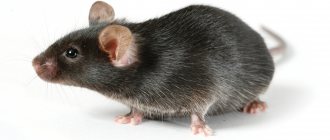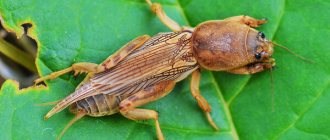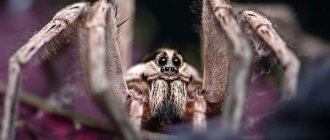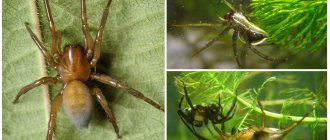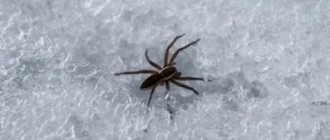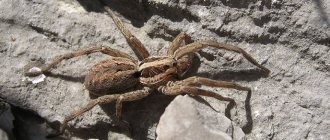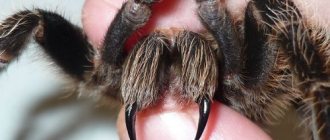Among spiders there are many poisonous representatives. One of them is a tarantula. Belongs to the phylum of arthropods. There are about 250 different spiders belonging to the genus Tarantula. They all have minor but characteristic features. Without special knowledge, it is difficult or even impossible to distinguish one species from another. The South Russian tarantula inhabits the territory of Russia and neighboring countries. There is a pronounced dark spot on the body of the representative. All tarantulas are both beautiful and terrifying. The insect has powerful legs covered with thick hairs.
Tarantulas are large and poisonous spiders
Where did the name come from?
There is no exact data regarding the name of the spider. There are only scientists' assumptions. It is believed that the name was given to the tarantula back in the Renaissance. At that time, any feverish conditions were associated with arachnid bites.
The largest number of bites was seen in one Italian town - Taranto. This is in the south of Italy. This is how the tarantula got its name, according to one of the most common hypotheses. At that time, in order to eliminate a feverish state in a patient, doctors prescribed a certain dance - the tarantella - to dance until exhaustion.
What are the main characteristics
The tarantula is classified as a member of the wolf spider family, despite its similarity to tarantulas. The insect has three rows of shiny eyes. The organs of vision are able to distinguish between light and shadow. The representative recognizes prey at a distance of 30 cm.
The spider has very good hearing
The tarantula has not only good eyesight, but also excellent hearing. The insect can detect human steps at a distance of 15 km. Depending on the subspecies, the spider grows up to 3-10 cm. The limb span is 30 cm.
Interestingly, the tarantula has the ability to regenerate lost limbs. When molting, the representative grows back the paws lost in the fight with the enemy. The size of the limb will increase after each molt.
Females are much larger than males. Some of the representatives can weigh about 100 grams. Body color directly depends on living conditions and subspecies. Color ranges from light to black.
There is a chelicerum on the head, which acts as an oral appendage and an attack weapon. Poisonous barbs are present.
Read on topic:
Where are funnel-web spiders found and are they dangerous?
14.11.2020
Why signs of arachnophobia appear and what to do about it
14.11.2020
The most popular types of Australian spiders
14.11.2020
The main types of spiders living in a house or apartment
05.02.2020
The spider has chelicerae
Why are tarantulas confused with tarantulas?
A small number of differences make it possible to confuse a tarantula with a tarantula spider. Let's get to know each of them in more detail to understand which arthropod belongs to each species.
Tarantulas
The photo shows a typical representative of arachnids.
The size of the entire body varies from 2.5 to 10 cm. Females can weigh up to 90 g. Most often, the female is larger than the male. Dimorphism (the difference between males and females) is also well developed in this species. Females may differ from males in larger sizes. And the forelimbs are always less developed.
More often the color of spiders is brown, black and gray. But there are also pure white individuals.
- Tarantula spider. Description, features and habitat of the tarantula spider
Small hairs cover the entire body of the animal. He also has chitinous armor, which can change more than once during his life.
Structure
- The body can be divided into two parts: abdomen and cephalothorax .
- The eyes can look around 360 degrees. This is achieved thanks to their unique arrangement. There are 4 eyes in a straight line. The remaining 4, larger ones, are distributed around the perimeter, in a trapezoid shape.
- The spider also has a developed sense of smell .
- The internal organs of the spider are located in the abdominal cavity.
- The size of the paws reaches up to 30 cm. The spider has 4 paws, thin bristles cover each of them. This only increases the support area. This measure is very necessary for movement on the surface of the water.
- Very noticeable will be the chelicerae (jaws) of the tarantula. They are oral appendages that serve both offensively and defensively.
Lifestyle
Tarantula leads a solitary lifestyle. During the breeding season, their likelihood of meeting a representative of the opposite sex increases. Males can quarrel with each other at any time, but this does not apply to the hibernation period.
Tarantulas are poisonous, but only dangerous to animals.
Tarantulas
The tarantula has a more exotic appearance. It is characterized by a juicy, bright and catchy color, shaggy and long limbs. The color becomes brighter and more intense with each subsequent molt.
They weigh from 65 to 170 g. The overall size is usually determined taking into account the span of the legs. The size of the spiders is about 28 cm.
Structure
- The body has an abdomen and cephalothorax
; they are covered with rather dense chitin. This shell reliably protects against excessive moisture loss and mechanical damage. - The cephalothorax is covered by a solid carapace. On its front part there are 4 pairs of eyes .
- The organs of movement consist of 6 pairs of limbs. 4 of them are paws. There is only one pair of chelicerae. The tarantula uses them for digging holes, hunting, dragging and protection, and performing a tactile function. Those chelicerae that have small poisonous glands are directed forward.
- There are thin receptors on the legs. They help identify the sound and smell of a tarantula.
Similarities of spiders
Externally, representatives of the two species are very similar. That is why there is confusion in their definition. The structure, as we have seen, is also quite similar. What helps to distinguish them?
What are the lifestyle features?
The burrows of large tarantulas can reach a depth of 50-70 cm. It is not difficult to notice a dwelling on the surface of the soil. In front of the entrance there is a special roller that masks the hole.
The spider is nocturnal. During the day it prefers to hide in burrows. It goes hunting only after sunset. At night, the insect also looks for a female for mating. Before the arrival of winter, the representative closes the entrance to the hole with dry plants. Cobwebs can be seen on all the walls of the house.
It is thanks to the web on the walls that the spider can pick up light vibrations and determine what is happening on the surface of the earth. The tarantula comes out with the arrival of spring after the soil and air warm up.
Tarantula can eat crickets
Tarantula feeds:
- caterpillars;
- crickets and bugs;
- mole crickets;
- small frogs, etc.
The insect can be kept at home. The main thing is to keep the temperature around 25-27 degrees. The arachnid is fed with small pieces of beef. You can only keep one tarantula per container. If there are two of them, constant clashes will occur.
How do tarantulas differ from tarantulas?
- The main difference is considered to be the structure of the chelicerae . In tarantulas they are located in parallel, and in tarantulas they are located along the median.
- The next difference is the sizes . Tarantulas are almost 2 times smaller
. - Another major difference will be the toxicity of the poison .
IMPORTANT! The tarantula is more poisonous than the tarantula.
- There is also a difference in the diet of spiders. The tarantula's food source is amphibians and small frogs. The diet of the tarantula spider includes cockroaches, crickets, and zophobas beetle larvae.
Moving away from the description of the various types of tarantula spiders, I would like to talk about the external structure of tarantula spiders, since the issue is quite topical and interesting. Beginning spider enthusiasts often come across confusing words like “Chelicera” or “Pedipalps,” and I have to spend some time explaining these concepts using third-party resources and pictures from the Internet.
In this regard, I decided to write a short article with the author’s photographs, which clearly shows the main elements of the external structure of tarantula spiders.
What are the main varieties
In total, there are 250 subspecies of tarantulas. Southern Russians live on the territory of the Russian Federation and neighboring countries. The main varieties of the family are presented in the table.
| South Russian | The size of the female reaches 3 cm. The male is slightly smaller. The color is brown or red. It lives in the forest-steppe and steppe zones in southern Russia. |
| Apuleian | Distributed throughout Europe. The size of the female reaches 8-9 cm. This is one of the most poisonous subspecies. The bite is often fatal. |
| Home | Domestic tarantula is a collective name for subspecies that people who prefer exotic pets like to keep. These are usually large and brightly colored South American varieties. |
It is interesting to know that some subspecies live up to 30 years.
They carry their spiderlings on themselves
Types of tarantulas
The genus Tarantula includes more than 200 species of spiders. Among them, the most famous are the following types.
Apulian tarantula (true tarantula)
It has a size of 7 cm. Females of this species are characterized by a combined coloration, consisting of a dark cephalothorax outlined by a light thin stripe and a red abdomen decorated with several transverse stripes framed by a red and white border. The male tarantula has a more modest, monochromatic appearance. Apulian tarantulas live mainly on mountain slopes in vertical burrows up to 0.6 m deep, which can be detected by a characteristic roll of dried leaves framing the entrance.
Unlike many of their fellow spiders, true tarantulas do not spin webs. During the day they prefer to hide in a hole, and at twilight and night hours they leave their shelter to hunt insects. On the eve of winter cold, poisonous spiders seal the entrance to their home using dry grass intertwined with cobwebs and hibernate.
The life expectancy of a tarantula in natural conditions after the onset of puberty does not exceed 2-3 years for males and 4-5 years for females. Apulian tarantulas live in countries such as Italy and Algeria, Spain and Libya, Portugal and Morocco, Egypt and Sudan.
South Russian tarantula or Mizgir
It is an inhabitant of fields, gardens and orchards, slopes of ravines and river banks. The habitat of the tarantula is the steppe, semi-desert and desert zones of Russia, Belarus, Ukraine and the countries of Central Asia. The size of the Mizgir tarantula rarely exceeds 35 mm in females and 25 mm in males. The color of the spider depends on the color of the soil in the area where it lives, so there are light brown, black-brown or reddish specimens with spots of various shapes and sizes.
A characteristic feature of this type of spider is the presence of a dark “cap” on its head. The depth of the burrows in which poisonous tarantulas live often reaches 0.5 m. The entrance to the burrow is protected by a low wall consisting of excavated soil and reinforced with grass and plant remains. During the rain or molting process, the entrance to the shelter is sealed with earth and cobwebs.
Like all members of the wolf spider family, Mizgiri do not weave webs to catch prey, but hunt insects while sitting in or near a burrow. In anticipation of the onset of cold weather, South Russian tarantulas descend to the very bottom of the hole, having previously sealed the entrance to it with a thick earthen plug. South Russian tarantulas live no more than 3-5 years. The life expectancy of females is longer than that of males.
Tarantula Lycosa narbonensis
Reaches a size of 5-6 cm. The body of the poisonous spider is brown-black, the legs are long, covered with hairs. Tarantulas are found in Italy, France, Macedonia, Malta, Spain, the countries of the former Yugoslavia and northern Africa.
Spanish tarantula
Lives in southern Europe and northern African countries. Tarantulas eat small invertebrates and also practice cannibalism. Previously, the spider was considered a subspecies of the Apulian tarantula, but since 2013 it has been considered as a separate species.
Brazilian tarantula
It lives in the countries of South America: Brazil, Uruguay, Paraguay, in the northern, northeastern and central parts of Argentina. Like other members of the genus, the Brazilian tarantula has 8 eyes arranged in 3 rows. In the bottom row there are 4 small eyes, a little higher there are 2 large eyes, and 2 more are on the sides of the head. The size of the tarantula is approximately 3 cm excluding the legs. The color of the spider is dark brown. There is a light longitudinal stripe on the head, which acquires a yellowish tint in the upper part of the back. In the center of the upper part of the abdomen, the stripe takes the shape of an arrow that points forward. The lower part of the abdomen of a poisonous spider is black. The chelicerae are reddish-brown in color. Tarantulas feed on crickets, cockroaches and other spiders.
Tarantula Lycosa poliostoma
Lives in South American countries: Brazil, Uruguay, Argentina, Paraguay. It lives in gardens, steppes, meadows, during the day it hides among the grass or in trees, in stones or holes, and is nocturnal. Like other species, these tarantulas eat crickets, cockroaches, small insects and other spiders. The length of the spider, excluding the legs, is 3 cm. The color of the tarantula is gray-brown or dark brown. There is a light longitudinal stripe on the head. In the upper part of the abdomen, the strip takes the shape of an arrow that points forward. The lower part of the tarantula's abdomen is black. The color of the chelicerae is light, which distinguishes this type of spider from the Brazilian tarantula. Females are larger than males, but females have shorter legs.
Tarantula Lycosa leuckarti
This is a gray-brown spider. The length of males reaches 0.9 cm, females - 1.2 cm (excluding paws). This species of tarantula lives in Australia.
Tarantula Lycosa coelestis
Lives in Japan and Taiwan. The length of females reaches 13-18 mm. The male tarantula measures 11-13 mm. The body color is brown, there are 2 longitudinal dark stripes on the back. The inner side of the tarantula's abdomen is black, for which the spider received the name "black-bellied tarantula."
What are the features of reproduction?
Mating begins towards the end of summer. After this, the male usually dies. The female partner begins active preparations for wintering. When it gets colder, the female closes the entrance to the burrow with plants. It crawls as deep as possible, where a stable temperature regime is maintained.
The female comes out only with the arrival of warmth. The spider basks in the sun for a short time, and then returns to the hole to lay eggs. Until hatching, the cocoon will always be with the arachnid for safety.
Hatched spiderlings leave their mother only after gaining independence. As spiders grow older, they enlarge their burrows.
One clutch, as a rule, contains 30-150 eggs. Egg ripening takes 40-50 days.
Reproduction and lifespan
Towards the end of summer, tarantulas become sexually mature. At these moments, males go out in search of females in the hope of mating. But these searches do not always end with the fulfillment of their desire. Sometimes the male may simply be eaten by the female. Therefore, in order to stay alive, they must not lose their vigilance for a single second.
When they meet, the males begin some kind of flirting. They actively vibrate their abdomen and move their forelimbs, giving a chance to understand their aspirations.
A female who is not against mating begins involuntary repetitions of all the movements of the male. After mating has taken place, it is advisable for the male to quickly retreat, otherwise he risks being eaten by a hungry spider.
The fertilized female has no choice but to hibernate in a well-walled hole. And only the arrival of spring makes it come to the surface.
In the abdomen exposed to the rays of the sun, offspring are formed in the form of eggs in the female. She lays already ripe eggs on the web she has prepared. The number of eggs depends on the species of tarantula. Their average number is about 400 pieces.
South Russian tarantula
The eggs are in the ripening stage. At the same time, the female builds a large cocoon, places her eggs there and attaches them to herself. The cocoon is on the spider until the first movements of the babies in it.
The female remains to gnaw the cocoon and help the offspring get out of it. Newborn spiders are in no hurry to leave their mother. They climb onto it and are placed there in several layers.
They live this way until the babies are able to eat on their own. After which the females have another mission - she needs to go around as much of the territory as possible and scatter her offspring over it. Tarantulas can live up to 20 years.
